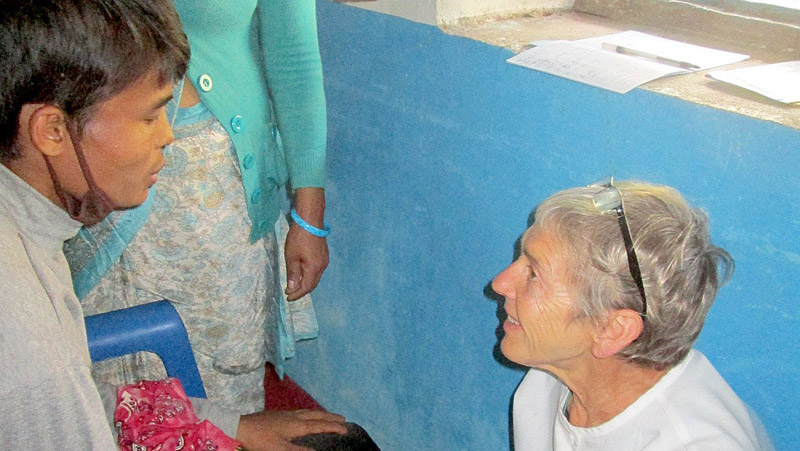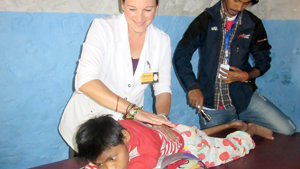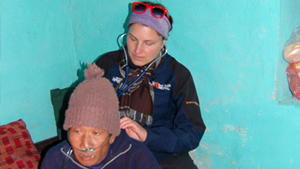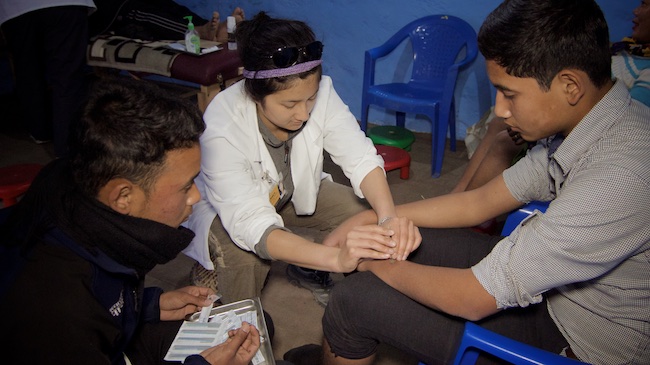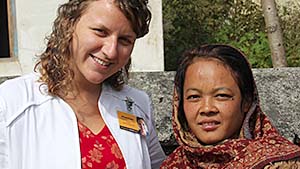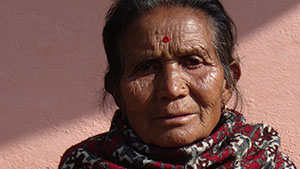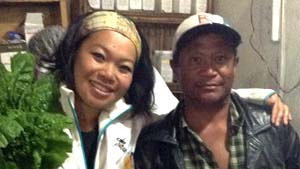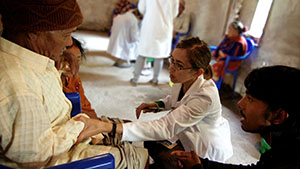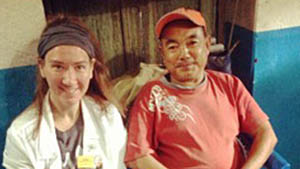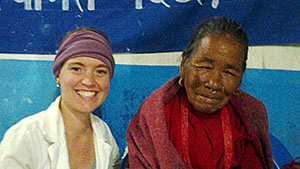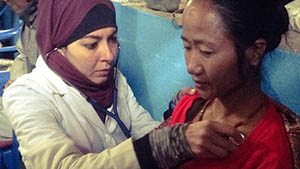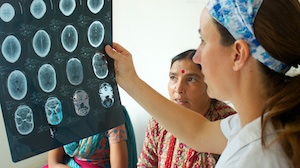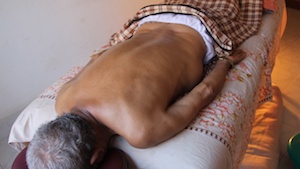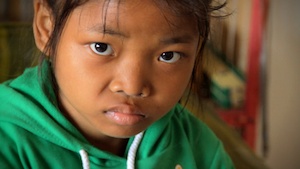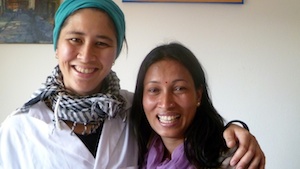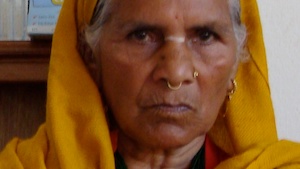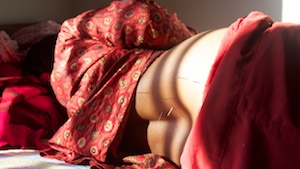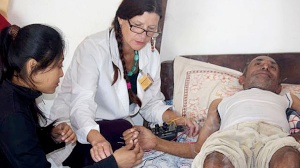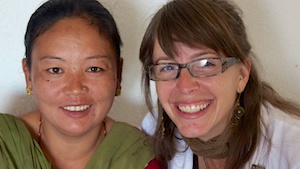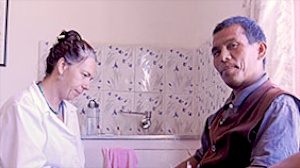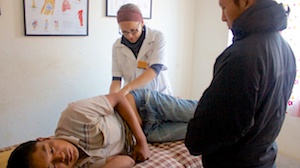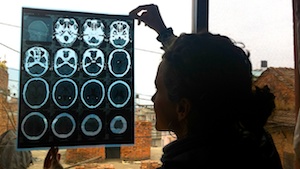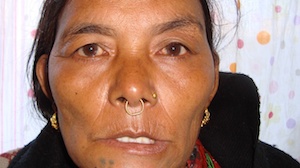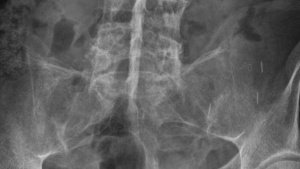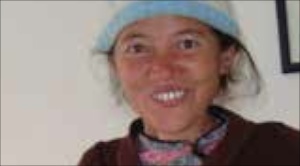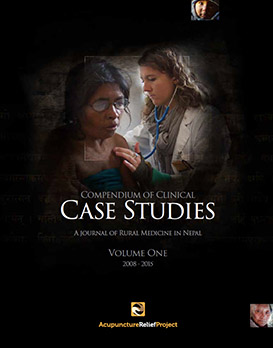Danielle Lombardi MAcOM LAc
October 2011
Overview
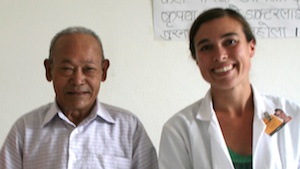
70-year-old male presents with severe cervical and lumbar pain, neuropathy of the arms, hands, legs and feet, incontinence of bowels and anal rash. His doctor has advised surgery. After 8 treatments he is able to sustain 40 -50% relief of pain for 4 days.
SUBJECTIVE
Patient presents with severe lumbar and cervical pain, reporting bilateral heaviness, weakness and tingling sensations in his arms and legs. He reports that the neuropathy is worse in his left arm, but is present in all 10 of his fingers, and brought on by cold water and cold temperatures. The tingling in his right leg is worse than in his left leg. Patient also has incontinence of bowels, occuring 4 to 5 times per day. Bowel movements are urgent, formed and easy to pass, but there is pain due to a rash around his anus. He reports feeling hot inside his body, especially at night. His doctor has advised surgery, but he is hopeful that acupuncture might reduce his pain enough to avoid surgery.
The onset of neck pain was 4 to 5 years ago, and the onset of back pain was 8 to 9 years ago. Patient relates his pain to a history of heavy labor, working as a field digger and brick carrier. For years he carried more than 60 kg on his back, but now he is unable to lift 200 g of weight. The pain came on gradually, but has become severe in the last year.
The limb neuropathy began 14 months ago after being hit from behind by a bus. He landed on his right medial knee, upper thigh, chin, nose, forehead and right anterior shoulder. There were no broken bones, but an MRI which was ordered on 4/13/11 revealed nerve damage. After the accident, he was unable to grasp food properly, count money or hold a glass.
The neuropathy radiates from the neck, down the right arm and into both hands. Patient reports heaviness, weakness and tingling in all fingers, but denies pain in the limbs. He can feel warm and cold, but he reports subjective numbness in both hands.
Patient reports no change in pain or neuropathy with time of day, but cold weather makes it worse and heat makes it better.
The neck and back pain are severe, and the symptoms are constant.
In the right leg, patient reports a cold, tingling sensation from sole to knee, which is most intense between the lateral ankle at GB40 and the lateral leg at GB34.
OBJECTIVE
Patient appears to be in relatively good health, but severely challenged by the pain in his neck and low back. He is unable to perform AROM and orthopedic tests due to the severity of his pain. He is unable to walk without support from his wife, and exhibits severe pain when standing up or beginning to walk. He also has difficulty balancing when standing up, almost falling over.
Sharp/dull test on the fingertips, arms and toes show no objective numbness. DTRs on bicep, triceps, brachioradialis, patella, hamstring and Achilles are normal. Grip strength is 50% weaker in left hand than right. Nail bed blanching shows normal circulation in both hands and feet.
Cervical AROM shows full range-of-motion with flexion and lateral flexion, extension and rotation, but with report of severe pain with motion. Cervical compression test increases neck pain and heaviness in arms. Cervical distraction test brings relief to neck pain and heaviness in arms. Upon palpation, there is severe pain and tenderness at left C2-C4 and right and left C6 and C7.
Lumbar flexion AROM is 80 degrees (normal 90) with pain on motion. Extension is 15 degrees (normal 30) with pain on motion. Lateral flexion is 20 degrees (normal 30) with pain. Rotation shows 25 degrees (normal 30) with pain on motion.
There is no radiation of pain with exams.
The muscles along the neck and back present with severe rigidity upon palpation. It is difficult to insert a needle without bending due to tenseness of erector spinae musculature.
Tongue: purple-red body, thin bright pink tip, slightly deviated to the right, transverse cracks and purple sublingual veins.
Patient records include:
April 13, 2011: CERVICAL MRI:
Cervical spondylosis of C4–C7
Bulge of disk posterocentral at C3–C4
C4–C5 (posterocentral protrusion of disk); narrowing of bilateral neural foramina with possible impingement of bilateral existing nerve roots
Diffuse bulge of disk with left posterocentral protrusion at C6–C7 with indentation of thecal sac and cord – possible impingement of existing nerve roots
Slight increased signal intensity in the cord at C5-C6 level with myelopathy
LUMBAR MRI:
Lumbar spondylosis
Right-sided spondylosis at L4 – minimal anterolisthesis of L4 over L5
Mild bilateral posterolateral bulge of the disk at L1–2, L2-3, L3-4 with mild narrowing of bilateral lateral canals
L4–L5 disk bulge/posterocentral protrusion – stenosis of bilateral lateral canal and neural foramina
Bulge of disk with annular tear and posterocentral protrusion at L5–S1 with mild compromise to central and lateral canal – no nerve root impingement
T2 sagittal image of dorsal spine shows minimal posterocentral bulge of the disk at T8–9, denting the thecal sac
ASSESSMENT
DX: Cervical spondylosis of C4-7, with nerve impingement at C5-7 and disk bulges at C4-7; Lumbar spondylosis, with right-sided spondylosis at L4, and disk bulges at L1–5
TCM DX: Bone bi syndrome; qi and blood stagnation of Bladder channel and Governing Vessel at cervical and lumbar regions due to and compounded by history of overwork and trauma; Underlying Kidney yin deficiency creating a malnourishment and deformity of bone, leading to qi and blood stagnation transforming into qi and blood deficiency; Qi deficiency and stagnation in the channels leading to neuropathy in the hands and feet
PROGNOSIS: Due to the physical deformity of the cervical and lumbar spine, complete recovery is unlikely. With continued acupuncture treatment in conjunction with stretching, traction, massage, electrostimulation and cupping, a decrease in pain and neuropathy is likely. The aim is to avoid or delay surgery for as long as possible with consistent acupuncture and conjunctive therapies.
INITIAL PLAN
Patient is treated at the clinic 3 to 4 times per week for 1 month, after which treatment progress will be assessed. Focus on Hua Tou Jia Ji (HTJJ) points in the cervical and lumbar regions to stimulate qi and blood circulation in local areas of degradation, disk bulging and pain. Teach patient stretching and exercises to reduce pain. Nourish Kidney yin, tonify qi and blood, move qi and blood.
Typical treatment: Acupuncture: HTJJ points needled deep at C4-7; HTJJ points at L1-5 needled wide and deep and angled medially, with bilateral electro-stimulation at 5 continuous frequency for 30 minutes; Electro-stimulation from S2 to DU2 bilaterally at 5 continuous frequency for 30 minutes; BL40, KI7, LR3
Cupping: Bilaterally along Bladder channel from cervical to lumbar region x 10
Massage: Tiger Balm or Bai Jie Balm applied with massage and pressure point therapy to neck, shoulders and low back
Traction: Neck and arms with a focus on neck for 10 - 15 minutes and arms for 2 minutes
OUTCOME
After 8 treatments, the patient reported 40 – 50 % improvement that lasted for 4 days after treatment. He also reported less pain with bowel movements due to the disappearance of the anal rash, as well as a 50% increase in his bowel control. He reported being able to walk for an hour and a half without trouble, and appeared to be able to sit, stand and walk without the distress that he exhibited in his first several visits to the clinic. Upon palpation, his musculature was also much less rigid than before.
CONCLUSION
This patient presented with a difficult case due to severe pain, the pressure of impending surgery and no significant change until treatment 7. This case teaches the importance of having the patience to adhere to the treatment plan. The strategy is now revised to a longterm plan of 3 visits per week for 6 months, after which the need for surgery will be reassessed.
With continued treatment over the next 6 months, the intention is to manage pain, regain balance and agility, reduce the neuropathy and regain bowel continence. Future treatment should be focused on acupuncture with conjunctive therapies: electro-stimulation, cupping, traction, stretching and massage.












